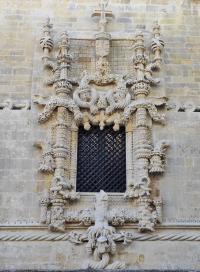- HOME
- MONUMENT
- Convent of Christ
- History
- Architecture
- Personalities
- King Afonso Henriques
- D. Gualdim Pais
- King Dinis
- King John I
- D. Lopo Dias de Sousa
- King Duarte
- Prince D. Henrique (Henry
- King John II (1455 - 1495
- King Manuel I (1469 - 152
- Diogo de Arruda
- João de Castilho
- Jorge Afonso
- Olivier de Gand
- King John III (1502 - 155
- Diogo de Torralva
- Friar Anthony of Lisbon
- Baltazar de Faria
- Filipe Terzi
- Philippine Dinasty
- King Philip II of Spain
- King John IV
- Domingos Serrão
- Queen Mary II
- Prince Fernando
- Costa Cabral
- Artisans and Artists
- Intangible Heritage
- Related Heritage
- Glossary
- VISIT OUR MONUMENT
- HERITAGE LEARNING
- TOMAR
- MONASTERIES ROUTE

Fair of Saint Iria
She was the daughter of Eugenia, a Latin name, and Hermínio, a Germanic name. In 653 a.C., Britaldo, son of the city governor, fell in love with Iria, a beautiful 15-year old girl, when they met in the Church of S. Pedro Fins.
The impossibility of getting Iria, for she was being prepared for religious life, left him mad. Remigio, a monk who was supervising Iria, also succumbed to her beauty! But once repudiated by the young girl, the monk took revenge by giving her an infusion that made her swell, as if pregnant. When learning of this "fact" and feeling betrayed, Britaldo sent to kill her as she prayed next to the River Nabão, by the Convent whose name would become Santa Iria´s, at the hands of the assassin Banão (anagram of the river's name).
Dragged down along the river, the body reached the Tagus, at Santarém, where, by divine grace, a tomb appeared that wrapped her around and allowed her veneration by all those who witnessed the miracle.
In honour of the Patroness and of this mythical legend, the Fair of Saint Iria is held in Tomar, integrating the Raisins Fair in October, with its most important day on 20th of October, the date celebrating Iria.
This fair was created by Royal Charter of Philip IV of Spain (King Philip III of Portugal), 3rd of October 1626, replacing the previous one, of St. Andrew. It was a Fair for small shopkeepers, silk men, hat makers, wicket weavers, grocers, rope makers, goldsmiths, shoemakers, potters, publicans, fishmongers, vendors of vegetables, bread, garlic, onions and nuts mats, tools and farming implements, screens and sticks, wood crates, blankets and clothing. This mercantile tradition still remains today, now allied of course with amusements and gastronomy offerings.
SERVICES - ACTIVITIES




